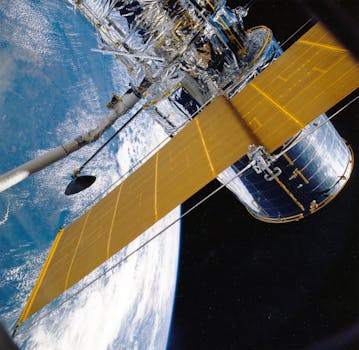LEO Satellites: The Future of Global Connectivity – LEO Satellites

LEO Satellites: The Future of Global Connectivity – LEO Satellites are revolutionizing the way we communicate and access the internet. LEO satellites are a type of satellite that orbits the Earth at an altitude of around 160 to 2,000 kilometers, which is much lower than traditional geostationary satellites. This lower orbit allows LEO satellites to provide faster and more reliable connections, making them ideal for applications such as broadband internet, IoT, and 5G networks.
The use of LEO satellites is becoming increasingly popular, with many companies, such as SpaceX, Amazon, and OneWeb, launching their own constellations of LEO satellites. These constellations are designed to provide global coverage, enabling people in remote and underserved areas to access the internet and other digital services. LEO satellites are also being used for a variety of other applications, including Earth observation, navigation, and communication.
One of the key benefits of LEO satellites is their ability to provide high-speed, low-latency connections. Because they are in a lower orbit, LEO satellites have a shorter distance to travel to reach the Earth, which reduces the latency and increases the speed of the connection. This makes LEO satellites ideal for applications that require real-time communication, such as video conferencing, online gaming, and virtual reality.
Another benefit of LEO satellites is their ability to provide global coverage. Because they are in a lower orbit, LEO satellites can provide coverage to areas that are not currently served by traditional satellites. This makes them ideal for providing internet access to remote and underserved communities, as well as for providing backup connectivity in areas where traditional communication infrastructure is limited.
How LEO Satellites Work
LEO satellites work by using a network of satellites that are in a low Earth orbit. These satellites are equipped with transceivers that allow them to communicate with devices on the ground, such as smartphones, laptops, and other wireless devices. The satellites use a variety of frequencies, including Ku-band, Ka-band, and V-band, to transmit and receive data.
The data is transmitted from the device to the satellite, which then relays the data to a ground station. The ground station then forwards the data to its final destination, which could be a server, a data center, or another device. The process is reversed for data that is being sent from the server to the device.
LEO satellites use a variety of technologies to provide high-speed, low-latency connections. These technologies include advanced modulation techniques, such as quadrature amplitude modulation (QAM) and amplitude shift keying (ASK), as well as beamforming and beam-steering technologies. These technologies allow the satellites to focus their signals on specific areas, increasing the speed and reliability of the connection.
Applications of LEO Satellites
LEO satellites have a variety of applications, including broadband internet, IoT, 5G networks, Earth observation, navigation, and communication. They are also being used for a variety of other applications, including disaster response, search and rescue, and environmental monitoring.
One of the most significant applications of LEO satellites is providing broadband internet access to remote and underserved communities. Many companies, such as SpaceX and Amazon, are launching constellations of LEO satellites that are designed to provide global coverage and enable people in these communities to access the internet.
LEO satellites are also being used for IoT applications, such as smart cities, smart homes, and industrial automation. They provide a reliable and secure connection for devices, enabling them to communicate with each other and with the cloud.
In addition to these applications, LEO satellites are also being used for navigation and communication. They provide a backup to traditional GPS systems, enabling devices to determine their location and velocity even in areas where GPS is not available.
Challenges and Limitations of LEO Satellites
While LEO satellites have many benefits, they also have some challenges and limitations. One of the biggest challenges is the cost of launching and operating a constellation of LEO satellites. Launching a single satellite can cost tens of millions of dollars, and operating a constellation of satellites can cost hundreds of millions of dollars per year.
Another challenge is the risk of interference from other satellites and devices. Because LEO satellites use a variety of frequencies, there is a risk that they will interfere with other satellites and devices that are using the same frequencies. This can cause errors and dropped connections, and can even cause the satellite to fail.
LEO satellites also have a limited lifespan, typically ranging from 5 to 10 years. This means that they must be replaced regularly, which can be expensive and time-consuming. Additionally, the satellites must be designed to withstand the harsh conditions of space, including extreme temperatures, radiation, and debris.
Conclusion
In conclusion, LEO satellites are revolutionizing the way we communicate and access the internet. With their ability to provide high-speed, low-latency connections, LEO satellites are poised to bridge the digital divide and enable global connectivity. While they have some challenges and limitations, the benefits of LEO satellites make them an exciting and promising technology for the future.




